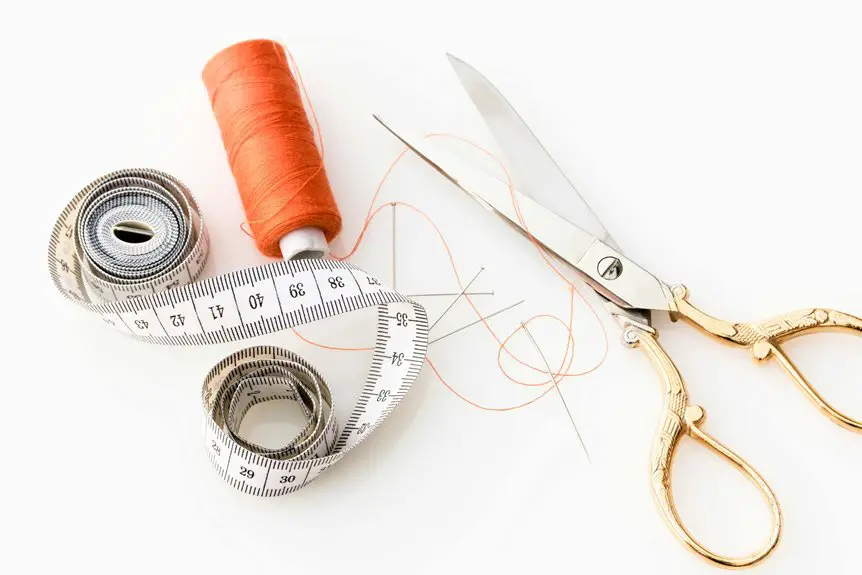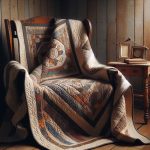Cotton sateen can be a great choice for quilting if you want a soft, smooth fabric with a subtle sheen that adds elegance to your project. You’ll appreciate its durability and vibrant colors, but be ready for some challenges like slipping fabric and visible needle marks. It requires gentle handling and slower sewing to avoid puckering. If you want to craft quilts with luxurious texture and shine, exploring how to work with sateen can really elevate your skills.
Table of Contents
Key Takeaways
- Cotton sateen offers a luxurious sheen and soft texture, enhancing quilt appearance with a subtle glow and smooth feel.
- Its tighter weave provides durability and vibrant colors, ensuring quilts remain fresh and long-lasting through washes.
- The slippery surface and fabric shift require careful handling, extra pins, and slower sewing to avoid misalignment.
- Needle marks and wrinkles show easily on sateen, so testing and gentle pressing are essential to maintain quality.
- Compared to traditional quilting cotton, sateen is less breathable and more prone to snagging, affecting comfort in warm climates.
Characteristics of Cotton Sateen Fabric
Cotton sateen offers a smooth, lustrous finish that sets it apart from regular cotton fabrics. When you touch it, you’ll notice the silky texture created by a satin weave, which uses more threads on the surface for that subtle sheen.
Despite its softness, sateen remains breathable and comfortable, making it pleasant against your skin. The fabric has a medium weight and drapes nicely, giving your projects a graceful look.
You’ll find it has a tighter weave than standard cotton, which makes it slightly more durable but also prone to a bit of sheen wear over time. Keep in mind, cotton sateen tends to wrinkle more easily, so you’ll want to handle it with care during cutting and sewing.
Advantages of Using Cotton Sateen in Quilting
One of the biggest benefits you’ll notice when working with sateen is its luxurious sheen, which adds an elegant touch to any quilt. You’ll also appreciate its smooth texture that feels great against the skin, making your quilt both beautiful and cozy. Cotton sateen’s durability means your quilt will last through many washes without losing its charm. Plus, it drapes nicely, allowing you to create quilts with fluid lines and professional finishes. Finally, sateen fabric often comes in rich colors that stay vibrant over time.
| Advantage | Benefit to You |
|---|---|
| Luxurious Sheen | Enhances quilt appearance |
| Smooth Texture | Provides cozy feel |
| Durability | Guarantees long-lasting quilts |
| Nice Draping | Allows professional finish |
| Vibrant Colors | Keeps quilt bright and fresh |
Challenges and Considerations With Cotton Sateen
While sateen offers many appealing qualities that enhance your quilting projects, it also comes with some challenges you should keep in mind.
Its smooth, shiny surface can be slippery, making it trickier to cut and sew accurately compared to cotton muslin or quilting cotton. You might find the fabric shifts more during stitching, requiring extra pins or careful handling.
Additionally, sateen tends to show marks from needles or pins more prominently, so you’ll want to test on scraps first. It can also be less breathable, so consider this for quilts meant for warmer climates.
Sateen shows needle marks more clearly and is less breathable—test first, especially for warm-weather quilts.
Finally, sateen may wrinkle or snag easier, so handling and washing with care is essential to maintain its look and durability in your finished quilt.
Comparing Cotton Sateen to Traditional Quilting Fabrics
Although sateen shares the same fiber base as traditional quilting fabrics, its weave and finish set it apart in feel and performance.
When you compare cotton sateen to the more common quilting cotton, you’ll notice sateen’s smoother, shinier surface and softer hand. Traditional quilting cotton tends to have a matte finish and a crisper texture, which makes it easier to handle and press.
Sateen’s sheen adds a luxurious look but can be slippery, making precise piecing more challenging. Also, sateen’s tighter weave offers less breathability than standard quilting cotton.
If you’re seeking a quilt with a subtle glow and silky feel, sateen might appeal to you. However, if ease of use and durability are your priorities, sticking with traditional quilting cotton is usually the better choice.
Techniques for Working With Cotton Sateen
Handling cotton sateen requires a few adjustments compared to traditional quilting fabrics. You’ll want to use a sharp needle, like a size 80/12, to prevent snagging its smooth surface.
Since sateen has a slight stretch, stabilize it with lightweight interfacing or starch before cutting to maintain crisp edges. When piecing, sew slowly and avoid stretching the fabric to keep seams aligned.
Press seams gently on the wrong side using a low heat setting to preserve the sheen. Because cotton sateen can shift, pin carefully or use clips to hold layers securely.
Finally, choose a slightly longer stitch length around 2.5 to 3 mm to prevent puckering. With these techniques, you’ll manage sateen’s unique qualities and create polished quilt blocks.
Best Projects for Cotton Sateen Quilting
You’ll find cotton sateen works beautifully for apparel and accessories, adding a smooth, polished finish to your quilts.
It’s also perfect for home décor items like pillow covers and table runners that need a touch of elegance.
Let’s explore which projects highlight its unique qualities best.
Apparel and Accessories
Why choose cotton sateen for your next apparel or accessory project? Its smooth texture and subtle sheen make it perfect for stylish, comfortable items that stand out. Cotton sateen holds quilting stitches well, ensuring durability without sacrificing softness. Whether you’re crafting a lightweight jacket or a chic tote bag, this fabric’s versatility shines.
| Project Type | Benefits | Tips |
|---|---|---|
| Quilted Jackets | Warm, breathable | Use lightweight batting |
| Tote Bags | Durable, elegant finish | Reinforce handles |
| Scarves | Soft, drapes nicely | Choose lighter quilting |
| Hats | Structured, stylish | Stabilize with interfacing |
| Gloves | Flexible, comfortable | Use fine quilting patterns |
Cotton sateen’s unique qualities make it a smart choice for fashionable, functional quilted apparel and accessories.
Home Décor Items
Quilting cotton sateen into home décor items brings a touch of elegance and durability to your living space. Its smooth, lustrous finish makes it perfect for pillow covers, table runners, and wall hangings, adding a subtle sheen that catches the eye.
You’ll appreciate how sateen holds up well to regular use, resisting wrinkles better than traditional quilting cotton. When working on placemats or quilted curtains, sateen’s slight stretch offers flexibility without losing shape.
Just remember to prewash your fabric to prevent shrinkage and maintain color vibrancy. While sateen is less breathable than some fabrics, it’s ideal for decorative items rather than heavy-use upholstery.
Frequently Asked Questions
How Does Cotton Sateen Fabric Impact Quilting Machine Needle Wear?
Cotton sateen’s smooth, slightly lustrous finish can cause your quilting machine needle to dull faster. You’ll want to change needles more frequently to keep stitching sharp and prevent fabric snags or skipped stitches during quilting.
Can Cotton Sateen Be Combined With Synthetic Fabrics in a Quilt?
Imagine blending smooth cotton sateen’s soft sheen with vibrant synthetic fabrics in your quilt. You can combine them, but watch for differing textures and stretch—mix carefully to guarantee your quilt stays beautiful and durable over time.
What Is the Environmental Impact of Producing Cotton Sateen Fabric?
You should know cotton sateen’s production uses lots of water and pesticides, impacting the environment negatively. Choosing organic or sustainably sourced cotton can reduce harm, helping you make eco-friendlier fabric choices for your projects.
Does Cotton Sateen Fabric Require Special Storage Conditions to Maintain Quality?
Think of cotton sateen as a delicate treasure; you’ll want to store it away from direct sunlight and moisture. Keep it in a cool, dry place, and you’ll preserve its silky sheen and softness beautifully.
How Does Cotton Sateen Fabric Perform in Outdoor or Picnic Quilts?
You’ll find cotton sateen isn’t the best for outdoor or picnic quilts since it can stain easily and isn’t very water-resistant. It feels soft but may fade or wear quickly in sun and rough use.
- The Use of Nonwovens in Construction and Civil Engineering - July 11, 2025
- The Use of Nonwovens in Construction and Civil Engineering - July 11, 2025
- The Use of Nonwovens in Construction and Civil Engineering - July 11, 2025





